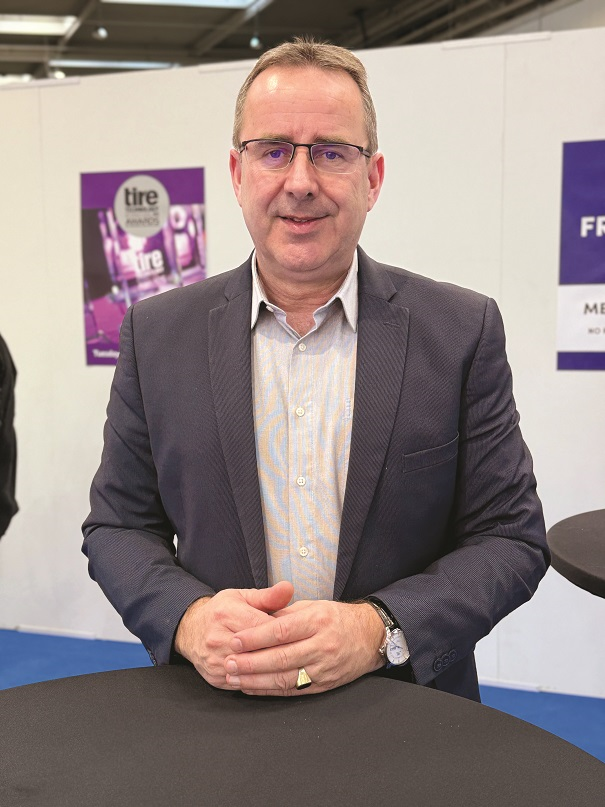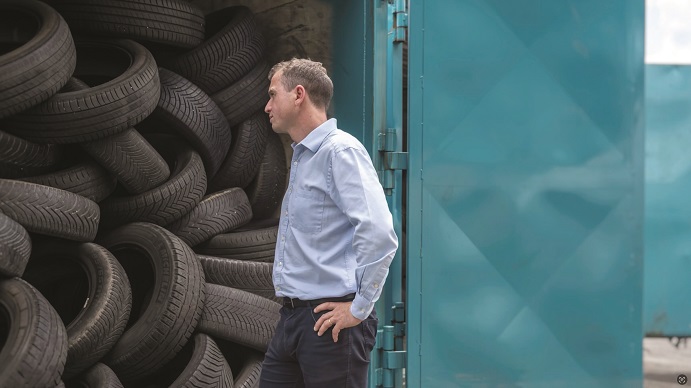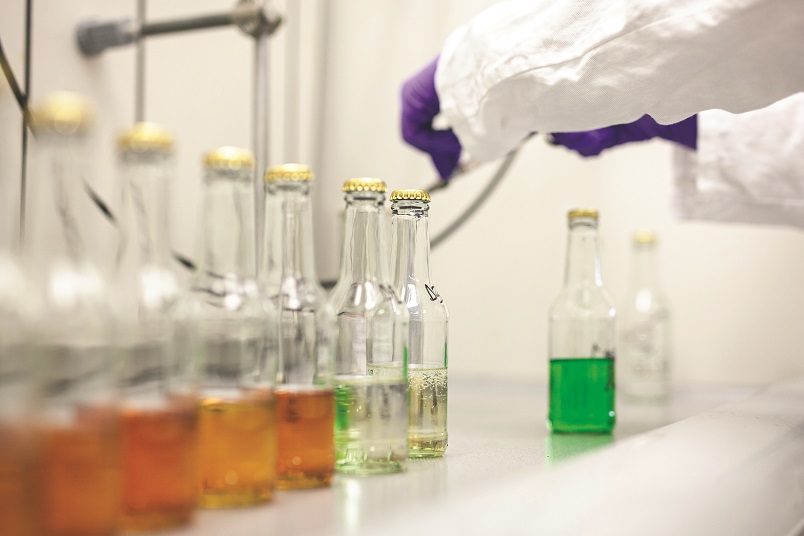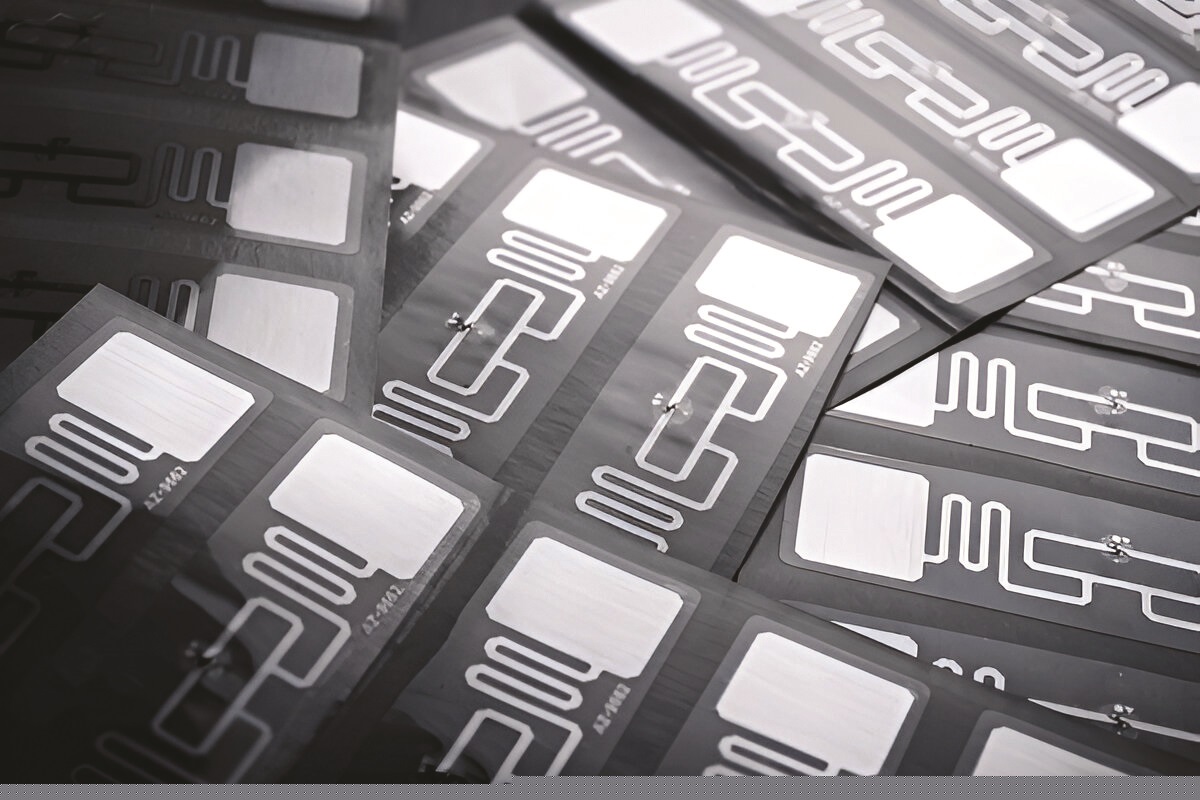Collaboration Is A Growing Need!
- By Sharad Matade & Gaurav Nandi
- June 30, 2025

The tyre industry has undergone significant changes over the past century, particularly in material composition and performance optimisation. While the external appearance of tyres may remain similar, advancements in rolling resistance and the integration of sustainable materials have reshaped the sector. Michelin, alongside its competitors, has been embracing innovation through collaborations to meet its ambitious 2050 sustainability goals, focusing on using 100 percent renewable and recycled materials. However, the challenge lies in scaling up recycling technologies and ensuring effective sorting. As the industry shifts, RFID technology and extended producer responsibility (EPR) regulations are emerging as critical tools for achieving material circularity and enhancing recycling efficiency.
Tyres have changed in the last 100 years. While the basic shape and colour might look the same, the internal composition has evolved significantly. Over the past century, and especially in the last 30 years, there have been major advances. One of the most significant has been the improvement in rolling resistance. Achieving lower rolling resistance without compromising grip has been a major technical challenge, and it has had a direct impact on fuel efficiency. In parallel, there’s been increasing focus on using more sustainable materials in tyre manufacturing. So, while it might not be obvious from the outside, there’s been substantial innovation under the surface.
However, it is a well-known fact that the tyre industry is secretive. Companies keep their research and development as tight as possible, but endeavours for including recyclable materials seem to break that ceiling, prompting towards collaborations.
Speaking exclusively to Tyre Trends, Sander Vermeulen, Vice President for End-of-life Rubber Products Recycling Business at Michelin, said, “There is a growing need and momentum for tyre companies to work more closely together, particularly around sustainability and materials innovation. Many companies have set ambitious goals for 2050, which include using 100 percent sustainable materials, achieving full recyclability or becoming carbon neutral. While each company may define these goals differently, the overarching direction is very similar.”
 “A good example of this shift is our recent collaboration with Bridgestone through the ‘Call for Action’ initiative. We discovered that both companies shared similar long-term ambitions. One major challenge we identified was the scalability of innovations, especially from recycling companies. Many of these innovations work well at small scale, but scaling them up to meet the needs of the global tyre industry is a different story. What’s promising is that instead of working in silos, we began engaging in open dialogue. Both Michelin and Bridgestone were receiving proposals for new materials but often found them unsuitable for tyre applications. Rather than simply rejecting these proposals, we asked that how we can help these suppliers improve the products,” he added.
“A good example of this shift is our recent collaboration with Bridgestone through the ‘Call for Action’ initiative. We discovered that both companies shared similar long-term ambitions. One major challenge we identified was the scalability of innovations, especially from recycling companies. Many of these innovations work well at small scale, but scaling them up to meet the needs of the global tyre industry is a different story. What’s promising is that instead of working in silos, we began engaging in open dialogue. Both Michelin and Bridgestone were receiving proposals for new materials but often found them unsuitable for tyre applications. Rather than simply rejecting these proposals, we asked that how we can help these suppliers improve the products,” he added.
He noted that together the tyre makers started defining shared specifications that outline the minimum criteria a new material must meet to be viable for tyre manufacturing. “It’s not a guarantee of adoption, but it provides a clear, transparent benchmark. And if a material doesn’t fall within that box, we can save time for ourselves and the suppliers,” added Vermeulen.
He also quipped that he had never imagined working so openly with a competitor like Bridgestone whilst strictly respecting antitrust rules. But the experience has been incredibly constructive.
Michelin’s 2050 target is bold as it seeks to make 100 percent of its tyres from renewable, recycled or sustainable materials. Recycling sits at the core of that ambition. Internally, the company is aligning efforts across departments to meet this goal with a near-term milestone of 40 percent sustainable content by 2030.
That percentage includes both recycled and bio-based materials. However, Michelin isn’t developing recycling technologies in-house. Instead, it’s working with a network of external partners to identify and scale promising innovations.
Among its collaborators are Enviro and Infiniteria as well as broader initiatives like Biobutterfly and the WhiteCycle consortium, which focuses on recovering textile fibres for tyres. The company remains open to any solution that can help close the loop on tyre materials.
As of the most recent annual report, Michelin reported that 31 percent of the materials used in its tyres are either renewable or recycled. This figure reflects the combined share of both categories, not recycled content alone.
Opining on whether recycled materials are easier to use in commercial or passenger tyres, Vermeulen said, “It really depends on the specific application. Some applications allow for a higher percentage of renewable or recycled content than others. But we don’t break down our targets or current performance by tyre category. The current figure we’ve communicated in our annual report is a global average across all types of tyres.”
EVOLVING VALUE CHAIN
As tyre companies remain steadfast towards the respective goals of using recycled and renewable materials, a glaring question that remains is the fate of current suppliers. Explaining how the value chain will be impacted once tyre companies reach the goals, Vermeulen stated, “They will also need to adapt. The entire value chain must evolve. That means synthetic rubber producers and oil suppliers need to develop renewable or recycled versions of the materials they currently provide. Everyone, from upstream raw material providers to downstream manufacturers, will need to contribute if we’re going to meet these ambitious goals.”

Commenting on whether such shift will restructure the entire tyre industry, he said, “It’s hard to make specific predictions, but one thing is clear that the entire value chain is already beginning to change. All raw material suppliers now understand the direction tyre manufacturers are heading. We’re already seeing many traditional suppliers exploring new approaches to reduce the reliance on fossil-based materials. Some are developing recycled alternatives, while others are exploring biobased feedstocks.”
“In this effort, a concept we explored in a large-scale European project was called BlackCycle. It brought together various actors from the entire tyre industry value chain including raw material suppliers and other stakeholders to map out how we can extract maximum value from end-of-life tyres. It looked at viable recycling pathways including how pyrolysis oil can be integrated into chemical supply chains. We all need to work together to co-create solutions based on renewable and recycled materials,” he added.
Michelin doesn’t plan to produce recycled materials itself. Instead, its focus is on defining performance and quality specifications, then partnering with companies ranging from start-ups to established suppliers that can deliver materials meeting those standards.
Commenting on the same lines, he added, “The entire tyre industry has a strong interest in gaining access to recycled materials that can be reused in new products. And to achieve that, partnerships are essential. There’s no way we can meet these ambitions if every company stays within its traditional boundaries and works in isolation. We believe in collaborating across the value chain. Often, smaller companies have breakthrough technologies or innovative ideas but lack the resources or infrastructure to scale. In those cases, if we can help them access funding or industrialise the processes, it’s a win-win for the industry as a whole.”
While performance gaps between recycled and virgin materials are a known concern, Michelin sees scalability as the more critical barrier. Many recycling innovations show promise at the lab or prototype level, but few are ready for industrial-scale production.

To bridge that gap, Michelin and others in the sector are working closely with innovators to help mature these technologies to meet industry demands.
REGULATION & TECHNOLOGY
The extended producer responsibility (EPR) has been a staunch advocate for recycling end-of-life tyres across countries. The regulation is not only limited to European markets but has expanding into countries like India too.
Commenting on whether EPR regulations will help drive more effective recycling, Vermeulen said, “Extended producer responsibility plays a key role in tyre recycling by making manufacturers responsible for collecting and recycling tyre after use. In countries with EPR laws, such as most of Europe, producers and importers must ensure proper tyre collection and recycling. This legally mandates tyre producers to manage the end-of-life stage of the products. However, EPR is not the only model that can ensure effective recycling. In regions without EPR, like the United States, tyre recycling is still managed through a free-market system driven by industry and service providers. Even in Germany, which lacks an EPR law, tyres are still collected and managed properly through industry-driven solutions.”
“While EPR can certainly help in places with limited infrastructure, the key to effective tyre recycling lies in how well the system is organised. Whether through EPR or free-market models, both can be effective as long as the collection and recycling infrastructure is well established,” he added.
Vermeulen also views RFID technology as a crucial enabler for achieving material circularity in the tyre industry. By embedding RFID tags, tyres can be tracked and identified with precise information about its composition, helping to streamline the recycling process. This technology allows for better sorting of tyres based on specific material make-up, which is critical for maximising the quality of recycled materials.

Just as with household recycling, the challenge is to ensure that materials are sorted effectively. With too many sorting categories, costs rise without guaranteeing better quality. RFID makes it easier to identify the correct ‘bin’ for each tyre, whether it’s a winter, truck or passenger car tyre.
Additionally, RFID can help differentiate between new, retreaded and partially worn tyres, which often have varying materials and recycling needs. This enables more efficient sorting, improving the overall quality of the recycling output while keeping costs manageable. Michelin sees RFID as an essential tool in making the recycling process more effective and economically viable.
Trinseo Launches 4th-Gen Binder To Power Longer-Range EVs And Reliable Energy Storage
- By TT News
- December 03, 2025

Trinseo has launched the Fourth-Generation SBR Binder Platform, designed to meet the evolving demands of electric vehicle and battery energy storage systems. This new technology underscores the company’s commitment to advancing high-performance materials for the global energy transition.
Created in close partnership with battery producers, the platform leverages sophisticated polymer science to deliver stronger electrode adhesion, enhanced energy density and greater overall durability. It achieves up to thirty percent higher peel strength than previous binder technologies, which facilitates thicker electrode coatings and faster manufacturing speeds – critical factors for improving battery capacity and extending vehicle range. The first offering under this platform, VOLTABOND 109 Latex Binder, provides exceptional versatility, performing reliably across various anode materials and supporting diverse cell designs and production environments.
In addition to boosting performance, the platform ensures improved high-temperature stability and reduced internal resistance, contributing to faster charging and long-term operational reliability. With manufacturing capabilities established across Asia-Pacific, Europe, and North America, Trinseo reinforces both supply chain resilience and regional support for battery producers worldwide.
This fourth-generation system is built upon decades of expertise in emulsion polymerization, setting the stage for future product developments tailored to different segments of the battery market.
Andre Hugentobler, Global VP Technology and Innovation, said, “Our Fourth-Generation Binder Platform represents a leap forward in materials innovation for both EV and ESS markets. It demonstrates how Trinseo’s polymer expertise and global manufacturing capabilities enable our customers to accelerate the next wave of electrification – safely, efficiently and at scale.”
Arthas Yang, Senior Vice President, Latex Binders, said, “This platform positions Trinseo to deliver differentiated solutions across multiple customer tiers and market segments. It reflects our ongoing investment in high-growth, high-value markets and our commitment to advancing mobility and energy solutions.”
Flexsys Develops First Viable Industry Alternative to 6PPD in Major Breakthrough for Tyre Chemistry
- By TT News
- December 02, 2025

Flexsys has created what it says is the tyre industry’s first practical and scalable alternative to 6PPD, marking a major step toward replacing a chemical used for decades but now under regulatory pressure.
The company said the new antidegradant is the result of several years of research and testing with federal laboratories, independent scientific groups and tyre makers. Early results show the material could match the performance and safety of 6PPD while avoiding the environmental risks linked to 6PPD-quinone, a transformation product identified in 2020.
Flexsys said the new chemistry provides the short- and long-term protection needed to stop tyres cracking or ageing. It is also designed to fit into existing rubber compounds with minimal changes, which could help manufacturers adopt it quickly. The company added that the product meets environmental and regulatory benchmarks, including criteria set by the Washington State Department of Ecology.
Importantly, the new molecule is not part of the “PPD” family, meaning it does not form quinone during use. Flexsys said this would remove the environmental impact associated with 6PPD-quinone. The company is also using many of the same intermediate chemicals already used in 6PPD production. This could allow manufacturers to rely on existing factory assets and speed the shift to the new technology.
“This achievement reflects our unwavering commitment to responsible innovation, built on decades of expertise in tire protection chemistry,” said Carl Brech, Chief Executive Officer of Flexsys. “Our solution is formulated to deliver the performance and reliability that tire makers expect and is designed for future environmental and regulatory standards.”
6PPD has been essential to tyre durability for 50 years. But studies published in 2020 showed that 6PPD-quinone could harm aquatic species, including coho salmon. Regulators and tyre producers have been looking for a safer option since then. Flexsys said its new antidegradant meets this challenge without reducing tyre safety.
“Our team set out to develop a next-generation antidegradant that meets the tire industry’s highest performance standards without compromising tire safety, while also reducing toxicity,” said Neil Smith, Chief Technology and Sustainability Officer. “I could not be more proud of the perseverance and dedication of the Flexsys R&D team. Our group has been highly motivated by both the technical challenges of this project as well as the positive societal impact that this work will ultimately have.”
Flexsys acknowledged support from the Sustainable Polymers Tech Hub in Akron, Ohio, part of the U.S. EDA Tech Hubs programme.
The company is now working on process optimisation to allow large-scale production. It is also in discussions with regulators around the world to secure approvals for commercial use. Testing with tyre makers is continuing.
“Flexsys is helping set the direction of the tire industry for the coming decades with this development,” Brech said. “We will continue to work tirelessly to bring this breakthrough to the market as soon as possible.”
Wacker, SICO Open China R&D Centre to Speed Rollout of Specialty Silanes
- By TT News
- December 02, 2025

Wacker Chemie AG has strengthened its position in China’s fast-growing market for silicone specialities by opening a new application development centre with joint-venture partner SICO Performance Material in the eastern city of Jining.
The 2,300-square-metre facility brings together several laboratories focused on organofunctional silanes, which are used as high-performance additives in plastics, coatings and adhesives. By locating the centre next to SICO’s production and scale-up lines, Wacker aims to shorten development cycles and move new products into the market more quickly. The companies said investment in the site is in the mid-six-figure euro range.
Tom Koini, who leads Wacker’s silicones division, said the opening marks an important step in its China strategy. “As a provider of innovative silicone specialties and solutions, we can use this development center to achieve a key milestone for our business in China. Our focus is on high-margin specialty silanes, for which demand in China is rising continuously. This investment together with our partner SICO strengthens our presence and commitment to the region,” he said.
Wacker, which took a majority stake in SICO in 2022, is seeking to build a larger share of China’s specialty chemicals market, where demand for hybrid polymers has increased for years. These materials help improve the mechanical and chemical properties of adhesives, sealants, coatings and engineered plastics, all of which are used in sectors such as electric mobility, electronics and power equipment.
At the opening ceremony, SICO General Manager Kevin Qu called the centre an investment in the long term. “We can now pool all of our silane expertise here at our application development centre. This know-how ranges from chemical product properties and supply chain matters through to questions of process engineering and current marketing trends. We will leverage this in-depth knowledge to develop forward-looking innovations for our customers. This marks a new chapter of success in the history of our joint venture,” he said.
The companies said the centre will act as a link between research, technical service and manufacturing teams. Scientists will focus on developing additives, adhesion promoters and stabilisers based on organofunctional silanes and functional silicone fluids.
- Association of Natural Rubber Producing Countries
- ANRPC
- Natural Rubber
- Monthly NR Statistical Report
ANRPC Publishes Monthly NR Statistical Report For October 2025
- By TT News
- November 29, 2025

The Association of Natural Rubber Producing Countries (ANRPC) has released its Monthly NR Statistical Report for October 2025, providing an overview of key developments in the global natural rubber sector.
According to the report, the global natural rubber market in October was characterised by a distinct bearish trend in pricing. This decline can primarily due to a significant surge in production and export activities, which were initially stimulated by the higher prices seen earlier in the year. Meanwhile, overall demand has remained relatively subdued.

Looking ahead to the full year, projections indicate a modest 1.3 percent increase in global production for 2025, a figure that follows a recent downward revision for Indonesia. On the demand side, consumption is anticipated to grow by a slight 0.8 percent, influenced by an upward adjustment to Indonesia's consumption data. Despite the current price pressures, market sentiment shows some mixed signs of improvement, particularly within the tyre trade of certain specific markets.







Comments (0)
ADD COMMENT